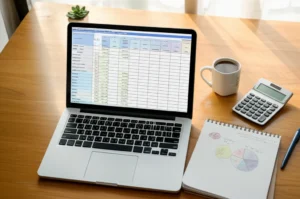Budgets, Coffee, and That Tricky “Where Did My Money Go?”
Let me just say it: if my wallet had a voice, it would straight-up sigh at the end of every month. You know that feeling? You set out with the best intentions—this is the month I’ll save, I’ll have money left for something fun, I’ll finally not dread checking my bank app. Cut to three weeks later: poof, the cash is gone, and honestly, you’re not even sure what happened. (Spoiler: it was probably snacks. Or that late-night “I deserve this” online treat.)
That’s the sneaky mistake most of us make. Not blowing the budget on a crazy yacht or a new phone—but just letting dollars drift away, one little “it’s only five dollars” at a time. Here’s the thing: creating a budget plan is not about being some spreadsheet-loving robot. It’s about getting your hands on a simple system, one that tells you where your money WANTS to go (not where it accidentally wanders off every month).
Why Bother? (Or, How Budgets Became the Best “Life Hack” No One Wants to Admit Using)
Would you believe me if I said the people who always seem chill about money aren’t necessarily richer? They’re just sneakier with their system. Imagine budgeting as that friend who’s quietly got your back—gently redirecting you (“put that back, it’s not in the plan!”) but also leaving room for the stuff that makes life joyful. Saves you some headaches, and hey, sometimes saves friendships (because who wants to be “that” person who always forgets to pay their half?).
But honestly, most of us stumble at the beginning. Why? Usually because someone (who shall not be named) once handed us a boring lecture about budgets. Or maybe you tried before—downloaded a fancy app, filled it out for two days, and then ghosted it like every group chat you ever joined for New Year’s resolutions. Still here? That means you’re already doing better than last month.
Personal Story: The $75 “Invisible” Money
I had a month—I tracked only my “real” bills. Rent, groceries, the obvious stuff. But at the end, I was $75 short… Turns out, it was all coffee runs, “emergency” takeout, and random vending machine snacks at work. That was the month I learned that tracking is way more important (and honestly, sometimes funnier) than any calculator.
Start Here: What’s Coming In, What’s Really Going Out
How do you create a simple budget plan? Step one: figure out what’s actually happening in your money world. This might sound boring, but stick with me—it’s like detective work. (Magnifying glass optional, vibe check required.)
Collect Your Money Clues
First thing: what do you bring home every month? No, not your “salary” on paper—the amount after taxes, after retirement stuff, after your job takes out everything it can think of. Called net income. If you’ve got a side gig, it counts. If you’re a student, it looks a bit different. (Wondering specifics? Check this super no-nonsense guide on How to make a budget plan as a student?—it’s a legit place to start.)
| Source | Monthly Amount | Notes |
|---|---|---|
| Main Job | $2,300 | after all deductions |
| Freelance Gig | $200 | averaged from last 3 months |
| Other (odd jobs/tutoring) | $75 | every other month |
| Total | $2,575 | Your real baseline |
Okay. Got your number? Awesome. Don’t judge it, don’t compare it—just own it.
Tally Up the Outflow (Brace Yourself)
Here’s the hidden gold: track ALL your spending. And I mean all—lunch at work, subscription you forgot to cancel, those “emergency” Uber rides (look, sometimes it’s raining). This only takes a few days to feel eye-opening, a week to get habits, and a month if you want the full tea. (Because let’s be honest: there’s always a random birthday or sale you totally forgot about.)
How to See What’s Sucking Up Your Money
Two main categories: Needs (rent, utilities, groceries) and Wants (dining out, endless streaming, random gadgets). It feels obvious, but the “wants” have a way of sneaking over into the “essential” list if no one’s looking. Here’s a sample:
| Type | Budgeted | Actual Spent |
|---|---|---|
| Groceries | $300 | $350 |
| Rent | $800 | $800 |
| Coffee | $30 | $56 |
| Takeout | $40 | $85 |
| Streaming | $20 | $20 |
| Total | $1,190 | $1,311 |
Okay, ouch. That coffee splurge is real. The point isn’t to guilt you—it’s to give you a chance to spot a pattern. (Did you know research on spending habits consistently points to these “invisible” expenses as the biggest budget busters? See this research on spending habits for a little more detail.)
Flip the Script with Fun Budget Goals
Now you’re probably wondering…how do you create a simple budget plan that doesn’t feel like financial jail?
Here’s my favorite part. Budgeting is all about real-life goals. What do you want that requires a little planning? (And don’t just say “retire at 30,” unless you’re winning the lottery. Let’s go for something doable!) Maybe it’s that vacation. Or a buffer, so bills stop being scary.
Short Dreams, Big Dreams—Mix Both
Saving for an “emergency fund” can sound super intimidating—like, who really has three months’ rent just chilling? But let’s break it down. $500 set aside is better than zero. Can you put $10/week in a jar or savings app? Trust me, seeing it build is weirdly satisfying.
If you’re the rule-following type (or just like things neat), you might love the 50/30/20 plan: 50% of your money goes to needs, 30% to wants, and 20% to savings/debt. But hey, maybe you’ve heard of the What is the 70-10-10-10 rule for money?—it’s a super handy breakdown for both newbies and seasoned savers. Options, right?
Table: Budgeting Rules at a Glance
| Method | Needs | Wants | Savings | Other |
|---|---|---|---|---|
| 50/30/20 | 50% | 30% | 20% | — |
| 70-10-10-10 | 70% | 10% | 10% | 10% (extra, like charity/investing) |
Pick whichever feels less intimidating. There’s really no “wrong”—as long as you stick with what feels realistic for you.
Putting It All Together (No, You Don’t Need a Fancy App)
How do you create a simple budget plan in practice? Here it is: take the money you bring in. Subtract all your “needs.” What’s left is up for grabs. But here’s the twist—decide where it goes BEFORE you “accidentally” spend it. That’s the magic: be the boss of your dollars, not the other way around.
The Classic Version (Pen and Paper FTW)
Write out all your expenses. Give yourself wiggle room—life’s weird. Maybe you overspend on groceries this month… just move that extra from “takeout” or “fun.” That’s not quitting. That’s being human.
And if you want a cheat sheet, here’s a Simple budget plan example for students free that’s actually, well, simple. (If you’re in school, or just like things pre-set, there’s also a Monthly Budget plan example for students that’s got your back.)
Reviewing (And Adjusting!) without Guilt
I cannot stress this enough: your first try will not be “right.” That is 100% normal. You’ll forget an expense, underestimate groceries, get a surprise bill. Review weekly—if you want—or at least once a month. Adjust. Be kind. Sometimes, overspending happens. Doesn’t mean you failed; it means you’re living. Keep goals in view, and tweak them as life shifts.
If You’re a Student—Or Just Surviving on Odd Jobs
Budgeting is even MORE important if your income is all over the place (hello, gig workers and college friends). Start with your lowest-earning month for planning—that way, all “extra” is a bonus. And if you need a solid walkthrough, check out the How to make a budget plan as a student? (because honestly, why make it harder than it needs to be?).
Making Budgets Stick in Real Life (And Still Living)
Let’s be real: the best budget is the one you’ll actually use past week two. So, how do you keep going when Netflix is calling your name, and that magical Target dollar spot just…exists?
- Celebrate wins: Paid off a card? Saved $20? Treat yourself (cheaply—think favorite food, not new shoes).
- Automate if possible: Have your bank move $10 to savings every payday, so you don’t forget (or chicken out at the last minute).
- Tweak, don’t trash: If the plan feels too tight, loosen a little. Goal is progress, not perfect math.
- Make it visual: Old-school jars, a whiteboard tracking debts, or an app that pings you. Whatever is easy to check—and fun to fill.
Remember, you can always peek at a Simple budget plan example for students free for inspiration, or try out a Monthly Budget plan example for students if structure helps you stay on track.
Reflection Check: What Will Your Budget Do for You?
Pause and imagine: What would you do with an extra $50 a month? $200? Maybe nothing dramatic—but wouldn’t it feel awesome just not to worry about running out of money before payday?
That’s the real answer to how do you create a simple budget plan: It’s not about restriction; it’s about control, confidence, and freedom to choose what matters to you (even if that “what” is a ridiculous snack, no shame).
Wrapping Up: You, But With A Plan
Here’s your sign. Stop waiting for next month, or until you “figure out” adulthood, or some fairy godparent drops off a magical spreadsheet. Today—right now—is the best (honestly, the only) time to start. Collect your numbers, notice your habits, give your money a mission, and let your plan evolve along the way.
Seriously. The first time you look back and see savings growing instead of stress? That’s when you’ll wish you’d started sooner (I sure did). And if you mess up? Laugh, adjust, try again next month. That’s growth. That’s progress.
What will your extra savings fuel—something practical? A wild splurge? A little more breathing room every day? Whatever it is, I’m cheering for you. If you ever get stuck, come back to these Simple budget plan example for students free or peek at the What is the 70-10-10-10 rule for money? for inspiration. We’re all learning together—one not-so-perfect, beautifully human budget at a time.













